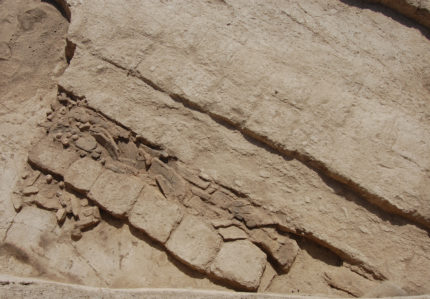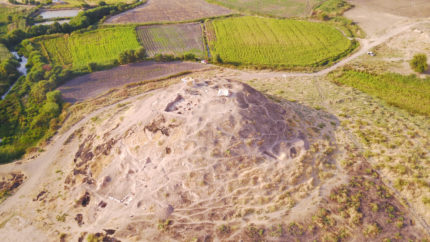
Archaeologists excavating the site of Gird-î Qalrakh in the Iraqi-Kurdish province of Sulaymaniyah have discovered a loom from the Sasanian period, around the 5th or 6th century A.D. The loom weights, made from clay, survive in a mudbrick structure with mudbrick shelving and/or benches in the interior. (Make sure to click on the image to see it full size because everything is baked mud color and looks the same in the small pic. You can see the round loom weights with holes in them clearly on the center left of the shot in the large version.)
Sasanian and even more ancient Neo-Assyrian remains have been found at Gird-î Qalrakh since it was opened to archaeological exploration after the ouster of Sadam Hussein, but the site is still largely unexplored, an alluring terra incognita that attracted the attentions of Prof. Dirk Wicke, expert in Near Eastern Archaeology from the Institute of Archaeology at Goethe University in Frankfurt. In 2015, he secured funding to lead a team of Goethe University archaeologists and students to the Shahrizor plain in Northern Iraq. This year’s six-week dig is the program’s second campaign.
The objective of the excavations on the top and slope sections of the settlement hill, some 26 meters high, was to provide as complete a sequence as possible for the region’s ceramic history. Understanding the progression in ceramics has long been a goal of research undertaken on the Shahrizor plain, a border plain of Mesopotamia with links to the ancient cultural regions of both Southern Iraq and Western Iran. These new insights will make it easier to categorise other archaeological finds chronologically. The excavation site is ideal for establishing the progression of ceramics, according to archaeology professor Dirk Wicke: “It is a small site but it features a relatively tall hill in which we have found a complete sequence of ceramic shards. It seems likely that the hill was continuously inhabited from the early 3rd millennium BC through to the Islamic period.”
However, the archaeologists had not expected to find a Sasanian loom (ca. 4th-6th century AD), whose burnt remnants, and clay loom weights in particular, were found and documented in-situ. In addition to the charred remains, there were numerous seals, probably from rolls of fabric, which indicate that large-scale textile production took place at the site. From the neo-Assyrian period (ca. 9th-7th century BC), by contrast, a solid, stone-built, terraced wall was discovered, which points to major construction work having taken place at the site. It is possible that the ancient settlement was refortified and continued to be used in the early 1st millennium BC.
That’s an extraordinary leap forward in understanding of a little known site accomplished in only six weeks, and it’s only scratching the surface. Dr. Wicke plans to return with his team next year to pick up where they left off, but first he has to ensure they have the financial support for a proper excavation and that the volatile political climate will be stable enough to keep everyone as safe as possible.

